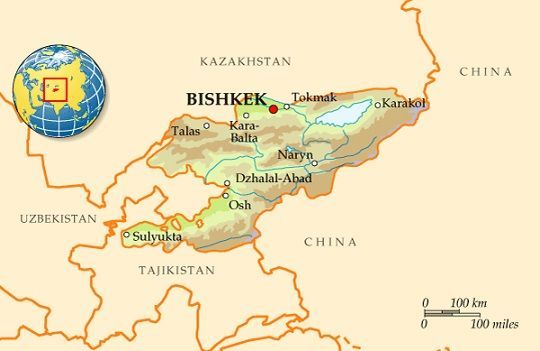For investors
The Kyrgyz Republic is located in Central Asia and has an area of 199,000 square kilometers, or 77,540 square miles, making it 85th largest country in the world. This landlocked nation stretches 900 km east to west and 410 km north to south, and is predominantly mountainous. The Kyrgyz Republic borders Kazakhstan to the north, Uzbekistan to the south-west, Tajikistan to the south, and China to the east and south-east. The climate is continental; temperature varies from -40°С in the winter to +40°С in the summer.
By its administrative and territorial system, the Kyrgyz Republic is a unitary state consisting of 7 oblasts. The capital is Bishkek, formerly Frunze. The Kyrgyz Republic has a permanent population of a little over 5.22 mln people, making it the least populated country in Central Asia. The population density in the Kyrgyz Republic is 26 people per square kilometer. About 90 different ethnic groups live in the Kyrgyz Republic. The Kyrgyz represent 69%, the Uzbeks 15%, and the Russians 9% of the population.
The national language of the Kyrgyz Republic is Kyrgyz, while the official language is Russian. Both languages are used nearly equally and are employed for administrative purposes; however, under the legislation of the Kyrgyz Republic, the Kyrgyz version of a document is considered to be its original version. In its official relations with foreign nations (receptions, meetings, development and ratification of documents) the Kyrgyz Republic uses Kyrgyz, while in relations with the CIS countries, it uses Russian. The political system of the Kyrgyz Republic is defined in the Constitution. According to separation of powers principle set forth in the Constitution, the state authority of the Kyrgyz Republic is represented by legislative, executive, and judicial branches operating under the rule of the President.
President: Sadyr Japarov
Chairman of the Cabinet of Ministers and Head of the Presidential Administration: Akylbek Zhaparov
Population (2017): 7,254,000 people
Life Expectancy (2017): 71 years (women – 75, men – 67)
Ethnic groups (2017): Kyrgyz 73.2%, Uzbek 14.6%, Russian 5.8%, Dungans 1.1%, other 5.3
Religious groups: Muslim 75%, Orthodox Christian 20%, other 5%
Languages: Kyrgyz (state language); Russian (official language)
Literacy rate: 98.7%
Capital and largest city: Bishkek (formerly Frunze) – 965.9 thousand people (2017)
Area: 76,641 sq mi (198,500 sq km)
Climate: Temperate continental, lowlands average summer temperature: 26* C, winter -5* C
Currency: Som
Time Zone: GMT +5
Administrative divisions: Seven oblasts (regions) divided into rayons (districts)
Legislature: Zhogorku Kenesh (Parliament) - seats by party: SDPK - 38, Respublika Ata-Jurt - 28, Kyrgyzstan - 18, Onuguu-Progress - 13, Bir Bol - 12, Ata Meken - 11
Judicial System: Based on civil law system of Kyrgyz Constitution
Economic summary:
GDP/PPP (2017): $22.64 bln.
GDP per capita/PPP (2017): $ 3,700
GDP growth rate (2017): 3.5%
Inflation (2017): 3.8%
Unemployment (2017): 7.4%
Major industries: textile industry, mining, energy
Exports (2017): $1.8 bln.
Exported goods (2017): gold, precious metals ($ 701 mln), ores ($ 144.3 mln), vegetables and fruits ($ 122.2 mln), clothing ($ 118 mln), vehicles and machinery ($ 111,7 mln), mineral fuels ($ 87.1 mln), aircraft, spacecraft ($ 78.1 mln)
Exporting countries (2017): Switzerland (45.54%), Kazakhstan (10.62%), Russia (10.20%), Uzbekistan (8.79%), Turkey (6.32%)
Imports (2017): $ 3.8 bln.
Imported goods (2015): mineral products, machinery, equipment and mechanisms, non-precious metals and their products, chemical products, food products, textiles and textile products
Importing countries (2017): China (38.11%), Russia (20.80%), Kazakhstan (16.53%), Turkey (4.96%), United States (4.00%):
Communications:
Mobile phone users (2015): ~ 7.5 mln.
Internet users (2015): 4,173,700
The level of Internet penetration in Kyrgyzstan (2014): 43.7%. Most of the access points to the Internet are concentrated in Bishkek (72%)
Transportation:
The total length of roads (2015): 34,000 km (19,000 km of public roads)
The length of the roads that make the international transport corridor and the main regional highways (2014): 2,242,000 km
Railroads: 470 km
Water roads: 600 km
Ports and harbors: Balykchy (Issyk-Kul province)
Sources:
https://www.cia.gov/library/publications/the-world-factbook/geos/kg.html




























